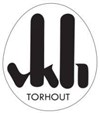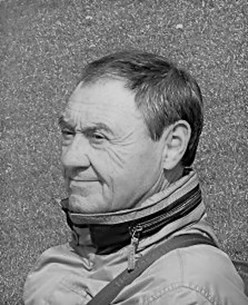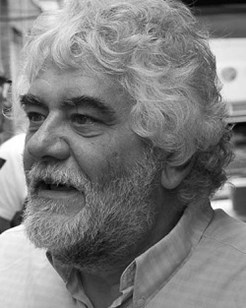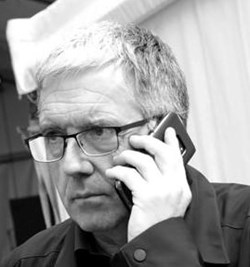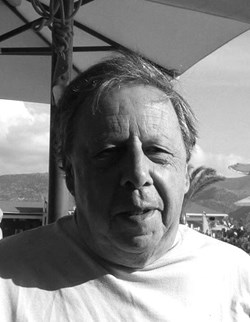Jeanfrançois Prins - El Gaucho
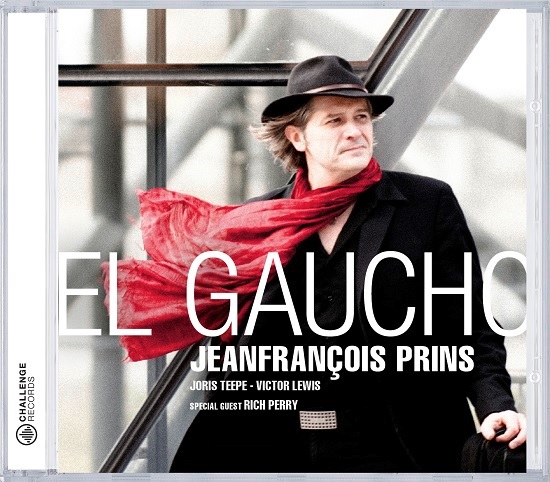
J
Challenge Records | CR 73337
Ein Gitarrist aus Belgien, der unterdessen in Brüssel wie auch in Berlin zu Hause ist, entführt uns musikalisch in die argentinische Pampa und zu den Gauchos. Vorhang auf für Jeanfrançois Prins! Mit ihm unternehmen wir zu Beginn eine Reise an den Schwarzen Nil und fragen uns, warum es nicht der Blaue Nil ist, erleben mit „Zorro“ ein Mantel-und-Degen-Abenteuer, verbringen eine Nacht in der Pampa („Noche en Las Pampas“) und flanieren auf der „5th Avenue“.
Das Repertoire der aktuellen CD besteht aus sechs Kompositionen von Prins („Wet“, „Zorro“, „Fifth Ave.“, „Noche en las Pampas“, „What?“ and „Futebol“), drei Stücken von Wayne Shorter („El Gaucho“, „Teru“ and „Black Nile“), zwei Standards („Spring is Here“ (1929) aus der Feder von Richard Rodgers und Lorenz Hart und „I’ll be Seeing You“ (1938), integriert in das Broadway Musical „Right This Way“) und einer Arbeit des Schlagzeugers Victor Lewis („I Wanted to Say“), der zur Band von Prins ebenso gehört wie der Saxofonist Rich Perry und der Bassist Joris Teepe.
Mit „Black Nile“ eröffnet Prins sein Album und lässt uns an den weichen Klangwellen teilhaben, die er als Thema wie auch in seinen Phrasierungen anstimmt. Bei den Phrasierungen umspielt er geschickt die Harmonien des Themas, derweil Bass und Schlagzeug für das rhythmisch-dynamische Beiwerk sorgen. Man kann sich als Zuhörer gut fallen lassen und mit geschlossenen Augen über den Nil schippern, derweil sich ein Teil der Band wie der Bassist Joris Teepe solistisch zeigt. Dabei interveniert Prins zu den tieftönigen Läufen mit kurzen Gitarrenattacken. Erst zum Schluss des Stücks bringt sich auch Victor Lewis am Schlagzeug mehr ins Spiel.
Um die Frage „What?“ zu beantworten, ist auch der Saxofonist Rick Perry gefragt. Begleitet von Gitarrenläufen eröffnet Perry diese Komposition von Prins. Dumpfes Bassgezupfe ist ebenso zu vernehmen. Die virtuosen Gitarrenläufe lassen im Verlauf des Stücks an die musikalische Umsetzung von Zweifel denken, der beschwichtigt werden soll. Es scheint ein gewisses Hin und Her, in das sich auch der Bass über weite Strecken einmischt. Abschließend hat dann wieder Perry mit seinem Saxofon die Oberhand bei der Frage nach dem Was.
Nachfolgend erscheint musikalisch der Rächer der Entrechteten auf der Bühne. „Zorro“ zeigt sich. Dabei unterstreicht Prins mit seinem Spiel die Faszination, die für ihn von diesem Helden der „Mantel-und-Degen-Filmwelt“ ausgeht. Rhythmik und Harmonie suggerieren, dass Zorro durch die Nacht reitet, immer unterwegs, um die Rechte der Armen zu erstreiten. Schneidig sind die Gitarrenpassagen, die wir zu hören bekommen. So erleben wir musikalisch Zorro, den Mann mit der Gesichtsmaske und dem Talent, den Degen gekonnt zu schwingen.
Mit „Noches en Las Pampas“ bleiben wir noch ein wenig in Lateinamerika. Dabei ist nicht zu überhören, dass uns Prins einen Hauch von Bolero präsentiert, fernab vom berühmten Bolero Ravels!
Gefolgt wird dieses Stück von einer weiteren Wayne Shorter Komposition. Als eine Hommage an den brasilianischen Fußball ist die Prins-Komposition „Futbol“ gedacht, obgleich die Nachfolger von Pele und Zico unterdessen längst entzaubert wurden, als die deutsche Nationalmannschaft bei der letzten WM einen historischen Sieg gegen die „Unbesiegbaren“ errang. Nein, Astrud Gilberto und Gil Gilberto gilt wohl nicht die Hochachtung von Prins. Eher muss man an Stan Getz und dessen Affinität zu brasilianischer Musik denken, wenn man sich in den Titel vertieft. Hört man nicht Dribblings, Spielverzögerungen und Flankenspiel, die da vom Saxofon musikalisch eingefangen werden? Wird der Gegner nicht durch Körpertäuschungen schwindlig gespielt?
Mit dem Standard „I'll be seeing you“ beendet Prins seine aktuelle, sehr gelunge Einspielung, die zwischen Latin Jazz und Jazz aus Europa changiert.
Text: © ferdinand dupuis-panther
Press release by Challenge Records
Recorded on March 28, 2011 and mixed on April 4, 2011 in Brooklyn, NY, “El Gaucho” is Jeanfrançois Prins’ latest recording as a leader. Jeanfrançois’ adult life has been focused on one thing: music. Mainly as a jazz guitarist, of course, performing and recording with many of today’s jazz masters. But also as a composer, arranger, producer for projects covering all styles of jazz, and stretching to world music, film scores, classical, avant-guarde, pop, and new music. He is involved daily in countless projects from solo to big band, collaborating with vocalists and instrumentalists alike. But for his new project, he wanted to get back to this most honest constellation, one of his favorite formats: the trio.
Jeanfrançois Prins’ vocabulary runs the gamut of jazz guitar, from horn-like lines to chord melodies, from tones inspired by his elders (Django to Hendrix to Scofield), he has a definitely recognizable sound and style, one where melody is what counts, however relaxed or adventurous the context may be. The repertoire consists of six of Prins’ originals (Wet, Zorro, Fifth Ave., Noche en las Pampas, What? and Futebol), three Wayne Shorter pieces (El Gaucho, Teru and Black Nile), two standards (Spring is Here and I’ll be Seeing You) and one Victor Lewis original (I Wanted to Say). A word about Prins’ originals: Zorro is as said earlier an epic latin melody, inspired by years of playing boleros and tango music, and by the image of this mythic hero, a mysterious masked noble man galloping on his faithful horse to fight injustice, and steal from the rich to give to the poor. Fifth Ave. was originally written for (and recorded by) Lee Konitz. It is a classic jazz waltz, which displays a rich harmonic progression and gives way to dynamic explorations. Noche en las Pampas is a bolero-like melody with a nostalgic tinge, which describes the campfire night of a solitary gaucho. What? is a line written on the re-harmonized chord progression of “I Hear a Rhapsody”. So, in a tradition coming from the Be Boppers and the Tristano school, it is an intricate and surprising melody performed sometimes unison, sometimes in harmony guitar-tenor sax, with the addition of the bass in the last melody.
Wet is a new line, inspired by the changes of “What is this Thing Called Love?”. The unison phrasing guitar-tenor sax of its angular melody participate in the mysterious mood of the piece, which in time explodes into hard swinging solos. Futebol is a fast samba inspired by the great Brazilian soccer players. Their deceiving moves are underlined by the meter changes – from 4/4 to 7/4 and 5/4 at times ...
About Jeanfrançois Prins
Joris Teepe and Jeanfrançois started working together a few years ago in small trio and quartet settings, but also teaching workshops and performing together in larger ensembles featuring soloists of such diverse styles as Andy Middleton, Randy Brecker, and Bill Evans to cite but a few. Joris’ solid time, tone and openess to diverse styles, and their musical affinity convinced Jeanfrançois that he would be a strong asset for this project and would complete a sound rhythmic bound with drummer Victor Lewis. Victor Lewis is a true master of modern music. Jeanfrançois first heard him many years ago with Stan Getz’ 4tet in Belgium. They worked together for the first time a few years ago, when Jeanfrançois produced, arranged and played on Judy Niemack’s « Blue Nights » project. Shortly after, they started performing in trio in major NYC jazz venues. Victor’s sense of space and sound, the way he makes every moment transparent, his deep understanding of harmony (he is a remarkable composer himself), his warmth and mastery of dynamics make him a perfect partner for Jeanfrançois’ multi-faceted music. Rich Perry is the trio’s guest on a few pieces. His depth of emotion, gorgeous tone and subtle mix of poetic abandonment and mean swing made him an obvious choice for Jeanfrançois with whom he had performed in the past.
Informationen
Label
Challenge Records
www.challengerecords.com
Musiker




